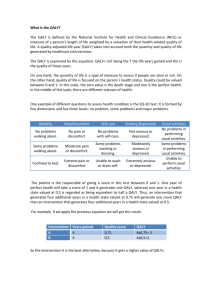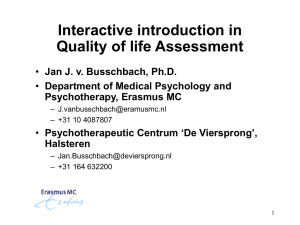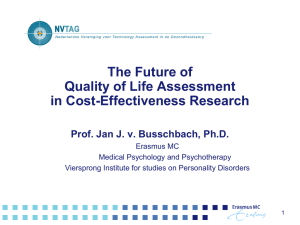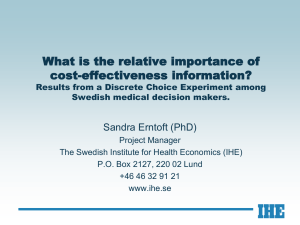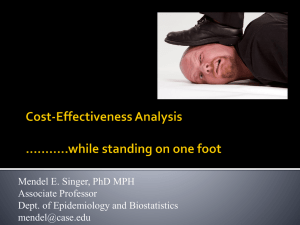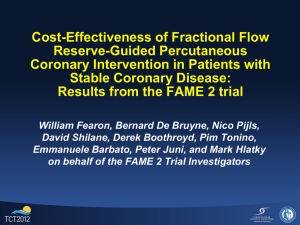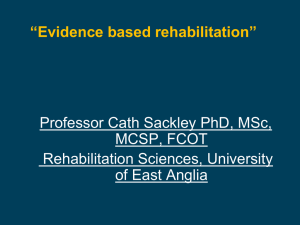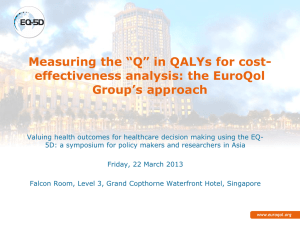Intro QALY & need assessment
advertisement
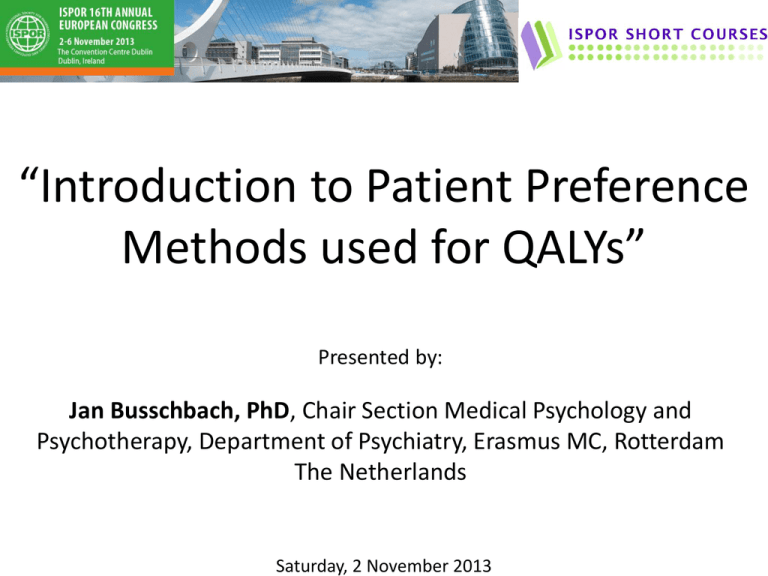
“Introduction to Patient Preference Methods used for QALYs” Presented by: Jan Busschbach, PhD, Chair Section Medical Psychology and Psychotherapy, Department of Psychiatry, Erasmus MC, Rotterdam The Netherlands Saturday, 2 November 2013 Utility Measurements Preference-based Techniques Prof. Dr. Jan J.V. Busschbach Erasmus MC Department for Medical Psychology and Psychotherapy Saturday, 2 November 2013: 14:00 - 18:00 2 Program before the break 14:00 – 14:30 Introduction + email questions 14:30 – 15:30 Indirect utility measurement (Presentation 1) Lecture: Introduction EQ-5D, HUI and SF-36 in QALYs (Presentation 2) Exercise: Indirect utility measurement (Exercise 1) Lecture continued: EQ-5D, HUI and SF-36 in QALYs (Presentation 2 continued) The difference between patient and social perspective (Presentation 3) 15:30 – 16:00 Direct utility measurement Lecture: Direct utility measurement: The validity of Standard Gamble, Time Trade-Off and Visual Analogue Scale (Presentation 4) 16:00 – 16:15 Break 3 Program after the break 16:15 – 17:00 Direct utility measurement Exercise: Direct utility measurement (Exercise 2) Discussion: which instrument when to use? – 17:15 Disease specific utility measurement 17:00 Lecture: Disease specific instruments for QALY-analysis + Person Trade-Off (Presentation 5) 17:15 – 17:45 Cultural differences 17:45 – 18:00 Round up (Presentation 7) 4 7000 Citations in PubMed Publications 1980[pdat] AND (QALY or QALYs) 1000 900 800 700 600 500 400 300 200 100 0 1975 1980 1985 1990 1995 2000 2005 2010 2015 5 Identification of major problems Issues emailed by participants What topics in quality of life research are most relevant/interesting for you and/or your work? 6 Health Economics Comparing different allocations Should we spent our money on • Wheel chairs • Screening for cancer Comparing costs Comparing outcome Outcomes must be comparable Make a generic outcome measure 7 Outcomes in health economics Specific outcome are incompatible Allow only for comparisons within the specific field • Clinical successes: successful operation, total cure • Clinical failures: “events” “Hart failure” versus “second psychosis” Generic outcome are compatible Allow for comparisons between fields • Life years • Quality of life Most generic outcome Quality adjusted life year (QALY) 8 Quality Adjusted Life Years (QALY) Example Blindness Time trade-off value is 0.5 Life span = 80 years 0.5 x 80 = 40 QALYs 1.00 X 0.5 x 80 = 40 QALYs 0.00 40 80 Life years 9 Area under the curve 1 QALY weights 0.9 0.8 0.7 0.6 Co-morbidity 0.5 Psychotherapy 0.4 No psychotherapy 0.3 0.2 0.1 0 0 10 20 30 40 50 Life years 60 70 80 Which health care program is the most cost-effective? A new wheelchair for elderly (iBOT) Special post natal care 11 www.ibotnow.com Dean Kamen Segway 12 Which health care program is the most cost-effective? A new wheelchair for elderly (iBOT) Increases quality of life = 0.1 10 years benefit Extra costs: $ 4,000 per life year QALY = Y x V(Q) = 10 x 0.1 = 1 QALY Costs are 10 x $3,000 = $30,000 Cost/QALY = 40,000/QALY Special post natal care Quality of life = 0.8 35 year Costs are $250,000 QALY = 35 x 0.8 = 28 QALY Cost/QALY = 8,929/QALY 13 QALY league table Intervention $ / QALY GM-CSF in elderly with leukemia 235,958 EPO in dialysis patients 139,623 Lung transplantation 100,957 End stage renal disease management 53,513 Heart transplantation 46,775 Didronel in osteoporosis 32,047 PTA with Stent 17,889 Breast cancer screening 5,147 Viagra 5,097 Treatment of congenital anorectal malformations 2,778 14 Two points of critique QALYs are measured in an invalid way Life years is not the problem, thus… It must be the validity of quality of life assessment… One should not use cost effectiveness Often referred to as ‘ethics’ 15 Eric Nord: Egalitarian concerns 1.0 A B C 0.0 16 Burden as criteria 30 25 20 15 10 5 0 Accepted High burden Rejected Low burden Pronk & Bonsel, Eur J Health Econom 2004, 5: 274-277 17 Costs/QALY as indicator of solidarity € 40.000 80 € 30.000 60 € 50.000 40 20 0 A B C 18 Costs/QALY versus Burden of disease X € 80.000 X € 60.000 X € 40.000 X € 20.000 € X 0 Burden of disease 19 Dutch Council for Public Health and Health Care (RvZ, 2006) 20 Burden of disease: QALY lost = DALY (Disability adjusted life year) DALY QALY Burden of disease expressed as “QALY lost” = DALY Disability adjusted life years The inverse of QALY Used by the WHO Expresses burden of disease Measure of priority More burden, more investment QALY lost (DALY) = Measure of solidarity 22 QALY: both for effectiveness and solidarity Evaluations assess cost-effectiveness in term of cost/QALY But many decisions can not be explained by cost/QALY Explanation in terms of fairness People disagree with distributional implications of QALY maximisation Fairness is burden of disease Burden of disease is QALY lost (DALY) 23 QALY debate Fairness is the issue in the QALY debate QALY measurement is the straw man Complex metric discussion QALYs are needed to operationalize fairness Most debate about quality of life assessment That debate = rest of the course 24 Most debate about the QoL estimates Unidimensional QoL In QALY we need a unidimensional assessment of Quality of life Rules out multidimensional questionnaires SF-36, NHP, WHOQOL 100 90 Scores on SF-36 80 70 General pop. 60 Diabetes II 50 Growth hormon def. 40 Depression 30 20 10 Ph ea lth in ra lH ily pa G en e Bo d Vi ta lit y ys ic al fu nc tio So ni ci ng al Fu nc tio ni ng Ro le Ph ys ic Ro al le em ot io na M l en ta lh ea lth 0 25 Direct utility assessment SG, TTO, PTO, VAS 26 Indirect utility assessment HUI, EQ-5D, AQoL, 15D, Rosser index MOBILITY I have no problems in walking about I have some problems in walking about I am confined to bed SELF-CARE I have no problems with self-care I have some problems washing or dressing myself I am unable to wash or dress myself USUAL ACTIVITIES (e.g. work, study, housework family or leisure activities) I have no problems with performing my usual activities I have some problems with performing my usual activities I am unable to perform my usual activities PAIN/DISCOMFORT I have no pain or discomfort I have moderate pain or discomfort I have extreme pain or discomfort ANXIETY/DEPRESSION I am not anxious or depressed I am moderately anxious or depressed I am extremely anxious or depressed 27
